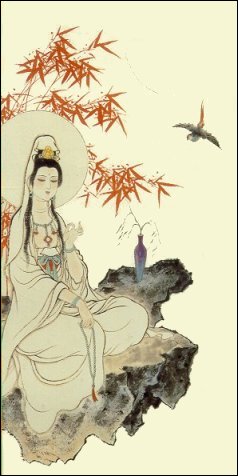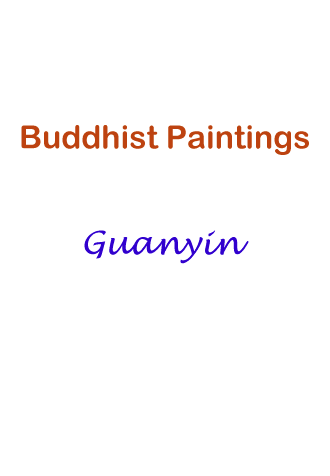



|
Guanyin is the most popular subject matter among all the Buddhist paintings in China. 
Guanyin was originally known as Bodhisattva Avalokitesvara and was depicted in the male form in the beginning. But later on the image became that of either a man or a woman, and eventually, since the Yuan Dynasty, the image gradually became predominantly that of a young woman, such as one holding a holy vase in her hand, pouring out holy water to save the multitude. Some people even call her the Goddess of Mercy or the Female Buddha. According to legend, Guanyin was born on the nineteenth of the second lunar month, achieved enlightenment on the nineteenth of the sixth lunar month and achieved nirvana on the nineteenth of the ninth lunar month. It is said that she is the top Bodhisattva beside Shakyamuni Buddha, and an assistant Bodhisattva beside Amitabha Buddha in the Western World of Ultimate Bliss. It is believed that any sentient being who recites her name during a disaster would be heard and salvaged by her, which can explain why she is the most worshipped figure in Buddhism in China. Literally in the Chinese language, "Guanyin" means "observing the sounds", which means Guanyin would always observe all the sounds from the world and always listen to requests from her worshippers. Although usually depicted as the image of an ordinary beautiful woman, Guanyin was said to present herself in 33 different forms in order to save the sentient beings from 12 disasters. Some said that she had 1000 hands, 1000 eyes, and with 11 looks, etc. In this regard, Guanyin's images in the various Buddhist paintings do reflect the multitude of forms and looks of this Bodhisattva, such as the so-called Holy Guanyin, Thousand-hands Guanyin, Eleven-looks Guanyin, Sitting-posture Guanyin, Reciting-beads Guanyin, Water-Moon Guanyin, Poplar/Willow-Branch Guanyin, White-Clothes Guanyin etc. Such variations certainly provide possibilities for all sorts of imagination for the artists in drawing the Bodhisattva. This category of Buddhist paintings is particularly appealing to the general public in depicting a stunning female beauty, which is quite an exception in Chinese religious arts. In a way, the visual images of Guanyin reflect the looks, attires, styles and ornaments of ordinary women in the old days, especially those in the Tang Dynasty. The image is also a demonstration of the traditional standards of aesthetics in ancient China. No wonder some people call the image of Guanyin the Oriental Venus! In this issue we would like to present a small collection of Guanyin paintings ranging from traditional Guanyin images to drawings by contemporary artists.
|